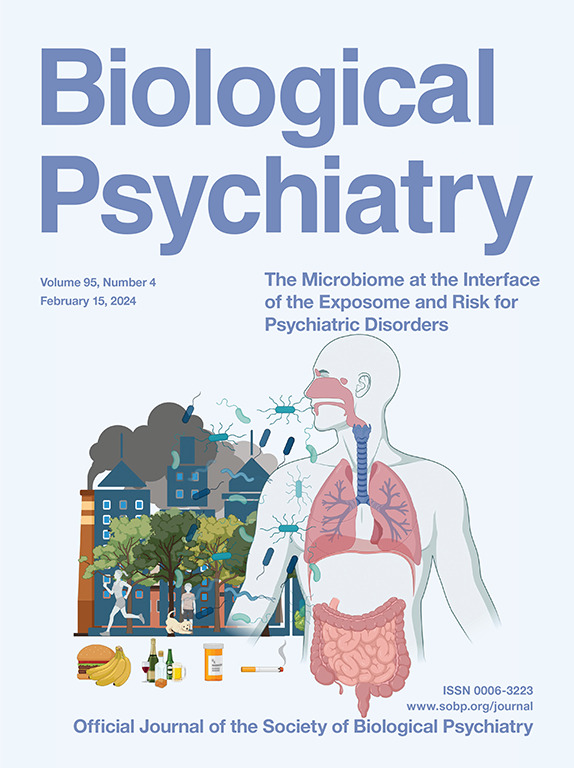基于大脑功能网络动力学和外周生理学的过早老化,发现精神疾病风险和治疗反应的性别差异标记。
IF 9
1区 医学
Q1 NEUROSCIENCES
引用次数: 0
摘要
背景:衰老是一个多层次的逐渐衰退过程,可预测发病率和死亡率。独立调查显示,大脑和外周生理机能的衰老与精神疾病风险有关,但目前尚不清楚这些影响是源于独特的机制还是共同的机制:为了解决这个问题,我们分析了健康老龄化队列(N= 427;年龄 36-100 岁)和两个特定疾病样本的临床、血液化学和静息状态功能神经影像学数据,这两个样本包括早期精神病患者(100 名,16-35 岁)和重度抑郁障碍(MDD)患者(104 名,20-76 岁):结果:我们发现新陈代谢衰老(即体内平衡失调)的血液化学标志物、大脑功能网络衰老和精神疾病风险之间存在性别依赖性耦合。在女性中,额顶和躯体运动网络的过早衰老与更严重的体内平衡失调有关。它还能预测情绪症状(抑郁/焦虑[所有三个样本]、失乐症[MDD])和社交退缩/行为抑制(回避型人格障碍[健康老龄化];消极症状[早期精神病])的严重程度和治疗阻力。在男性中,默认模式、丘脑-小脑和视觉网络的过早老化与平衡失调的减少有关,并预示着敌意/攻击症状(反社会人格障碍[健康老化];躁狂/阳性症状[早期精神病])、思维过程受损(早期精神病、多发性硬化症)和躯体问题(健康老化、多发性硬化症)的严重程度和治疗阻力:我们的研究结果确定了大脑动力学、外周生理学和精神疾病风险之间的性别双态关系,表明考虑性别和其他相关个人特征可能会提高潜在风险生物标志物和精准疗法的特异性。本文章由计算机程序翻译,如有差异,请以英文原文为准。
Sex-Differential Markers of Psychiatric Risk and Treatment Response Based on Premature Aging of Functional Brain Network Dynamics and Peripheral Physiology
Background
Aging is a multilevel process of gradual decline that predicts morbidity and mortality. Independent investigations have implicated senescence of brain and peripheral physiology in psychiatric risk, but it is unclear whether these effects stem from unique or shared mechanisms.
Methods
To address this question, we analyzed clinical, blood chemistry, and resting-state functional neuroimaging data in a healthy aging cohort (n = 427; ages 36–100 years) and 2 disorder-specific samples including patients with early psychosis (100 patients, 16–35 years) and major depressive disorder (MDD) (104 patients, 20–76 years).
Results
We identified sex-dependent coupling between blood chemistry markers of metabolic senescence (i.e., homeostatic dysregulation), functional brain network aging, and psychiatric risk. In females, premature aging of frontoparietal and somatomotor networks was linked to greater homeostatic dysregulation. It also predicted the severity and treatment resistance of mood symptoms (depression/anxiety [all 3 samples], anhedonia [MDD]) and social withdrawal/behavioral inhibition (avoidant personality disorder [healthy aging], negative symptoms [early psychosis]). In males, premature aging of the default mode, cingulo-opercular, and visual networks was linked to reduced homeostatic dysregulation and predicted the severity and treatment resistance of symptoms relevant to hostility/aggression (antisocial personality disorder [healthy aging], mania/positive symptoms [early psychosis]), impaired thought processes (early psychosis, MDD), and somatic problems (healthy aging, MDD).
Conclusions
Our findings identify sexually dimorphic relationships between brain dynamics, peripheral physiology, and risk for psychiatric illness, suggesting that the specificity of putative risk biomarkers and precision therapeutics may be improved by considering sex and other relevant personal characteristics.
求助全文
通过发布文献求助,成功后即可免费获取论文全文。
去求助
来源期刊

Biological Psychiatry
医学-精神病学
CiteScore
18.80
自引率
2.80%
发文量
1398
审稿时长
33 days
期刊介绍:
Biological Psychiatry is an official journal of the Society of Biological Psychiatry and was established in 1969. It is the first journal in the Biological Psychiatry family, which also includes Biological Psychiatry: Cognitive Neuroscience and Neuroimaging and Biological Psychiatry: Global Open Science. The Society's main goal is to promote excellence in scientific research and education in the fields related to the nature, causes, mechanisms, and treatments of disorders pertaining to thought, emotion, and behavior. To fulfill this mission, Biological Psychiatry publishes peer-reviewed, rapid-publication articles that present new findings from original basic, translational, and clinical mechanistic research, ultimately advancing our understanding of psychiatric disorders and their treatment. The journal also encourages the submission of reviews and commentaries on current research and topics of interest.
 求助内容:
求助内容: 应助结果提醒方式:
应助结果提醒方式:


